

III.2.16 Palladium-Catalyzed Asymmetric
Cross-Coupling
TAMIO HAYASHI
A. INTRODUCTION
Palladium complexes as well as nickel complexes are known to catalyze the reaction of organometallic reagents (R—m) with alkenyl or aryl halides and related compounds (R —X) to give cross-coupling products (R—R ), which provides one of the most useful synthetic means for making a carbon – carbon bond [1]–[5] (Scheme 1). The catalytic cycle of the reaction is generally accepted to involve an unsymmetrical diorganometal complex LnPd(II)(R)R as a key intermediate (Sects. III.2.1–III.2.14). From this intermediate the product R—R is released by reductive elimination to leave an LnPd(0) species that undergoes oxidative addition to R —X, generating an intermediate LnPd(II)(X)R . Transfer of an alkyl group from R—m to this intermediate by transmetallation reproduces the diorganometal complex. Since most of the palladium and nickel catalysts used successfully for the cross-coupling have tertiary phosphines as ligands, optically active phosphine ligands have conveniently been used to make the metal complexes function as chiral catalysts. As organometallic reagents (R—m), relatively reactive organomagnesium and organozinc reagents have often been used for asymmetric cross-coupling. Only a few examples have been reported on the application of cross-coupling with organoboron or organotin reagents to the asymmetric synthesis. The organic electrophiles (R —X) used for the catalytic crosscoupling are aryl and alkenyl halides or pseudohalides, such as triflates, in which the new carbon – carbon bond is formed on the sp2 carbon center, indicating that the creation of chiral carbon centers or chiral molecules by catalytic cross-coupling is not always easy. For asymmetric synthesis by this cross-coupling process, special systems have been designed. One is the reaction of secondary alkyl Grignard reagents, where a kinetic resolution of the racemic reagents is expected, and the other is enantioposition-selective asymmetric crosscoupling forming axially chiral and planar chiral molecules.
B. ASYMMETRIC CROSS-COUPLING OF SECONDARY ALKYL GRIGNARD AND ZINC REAGENTS
Asymmetric synthesis by the catalytic cross-coupling reaction has been studied most extensively with secondary alkyl Grignard reagents. Asymmetric cross-coupling with
Handbook of Organopalladium Chemistry for Organic Synthesis, Edited by Ei-ichi Negishi ISBN 0-471-31506-0 © 2002 John Wiley & Sons, Inc.
791

792 |
III Pd-CATALYZED CROSS-COUPLING |
chiral catalysts allows transformation of a racemic mixture of the secondary alkyl Grignard reagent into an optically active product by kinetic resolution of the Grignard reagent. Since the secondary alkyl Grignard reagents usually undergo racemization at a rate comparable to the cross-coupling, the enantiomerically enriched coupling product is formed even if the conversion of the Grignard reagent is 100% (Scheme 2).
|
[M] (catalyst) |
|
R−m + R′−X |
|
R−R′ + mX |
|
||
M = Pd (Ni)
m = Mg, Zn, Al, Zr, Sn, B, Si, etc. R′ = aryl, alkenyl
X = Cl, Br, I, OSO2CF3, OPO(OR)2, etc.
|
|
|
|
|
|
|
oxidative addition |
|
|
|
|
|
|||||||
|
|
|
|
|
|
|
|
R′−X |
|
|
R′ |
||||||||
|
|
|
LnPd |
|
|
|
|
|
|
|
|
LnPd |
|||||||
|
|
|
|
|
|
|
|
|
|
|
X |
||||||||
|
|
|
|
|
|
|
|
||||||||||||
|
|
|
|
|
|
|
|
|
|
|
|
|
|
|
|
|
|||
|
|
R−R′ |
|
|
|
|
|
|
|
|
R−m |
||||||||
reductive elimination |
|
|
|
R′ |
transmetallation |
||||||||||||||
|
|
|
|
|
|
|
|
LnPd |
|
|
|
|
|
||||||
|
|
|
|
|
|
|
|
|
|
R |
|
|
|
|
|
||||
|
|
|
|
|
|
|
|
Scheme 1 |
|
|
|
|
|
||||||
|
|
|
|
|
|
|
|
|
|
|
|
|
|
|
|||||
R1 |
|
|
|
R1 |
|
|
R3−X′ |
R1 |
|||||||||||
C |
|
MgX |
|
|
|
|
XMg |
|
C |
|
|
|
C |
|
R3 |
||||
|
|
|
|
|
|
|
|
|
|
|
|||||||||
|
|
|
|
|
|
|
|
ML* |
|
||||||||||
|
|
|
|
||||||||||||||||
H R2 |
|
|
|
R2 H |
|
|
|
H R2 |
|||||||||||
|
|
|
|
|
|
|
|||||||||||||
|
|
racemic |
|
|
|
|
|
|
|
|
|
|
enantiomerically |
||||||
|
|
|
|
|
|
|
|
|
M = Pd (Ni) |
|
|
enriched |
|||||||
|
|
|
|
|
|
|
|
|
|
|
|
|
|
||||||
Scheme 2
In the first reported examples of asymmetric Grignard cross-coupling, a nickel complex coordinated with ( )-diop (4) was used as catalyst for the reaction of 1-phenylethyl Grignard reagent (1) with vinyl halide (2) giving (R)-3-phenyl-1-butene (3) and that of 2-butyl Grignard reagents with phenyl halides giving (R)-2-phenylbutane.[6],[7] The enantioselectivity was slightly dependent on the halide atoms of both the Grignard reagents and organic halides, the highest being 17% ee.
After these findings, asymmetric cross-coupling of the secondary alkyl Grignard reagents has been attempted using various kinds of optically active phosphine ligands. The reaction most extensively studied so far is that of 1-phenylethylmagnesium chloride
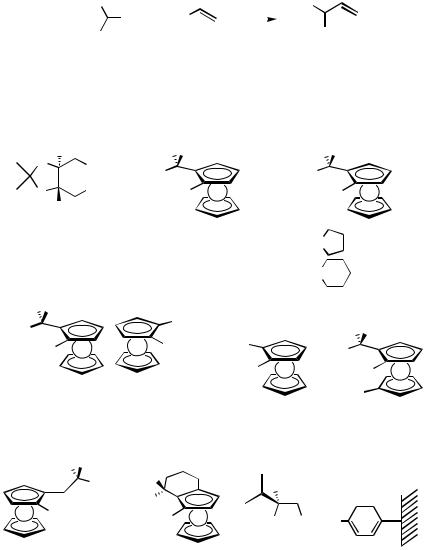
III.2.16 Pd-CATALYZED ASYMMETRIC CROSS-COUPLING |
793 |
(1) with vinyl bromide (2) (Scheme 3). The cross-coupling proceeds generally in high yields in diethyl ether at 0 °C or lower temperature in the presence of not more than 1 mol % of the catalyst coordinated with chiral phosphine ligands. At an early stage, nickel complexes were mainly used. They are isolated nickel – phosphine complex NiCl2P* or in situ catalyst generated from NiX2 (X Cl or Br) and a phosphine ligand L*. The preformed palladium complex PdCl2L* also catalyzes the asymmetric cross-coupling, although the examples of the use of palladium catalysts for this asymmetric Grignard cross-coupling are few. Some of the representative results obtained with nickel and palladium catalysts are summarized in Scheme 3.
Me |
|
M/L |
* |
|
Me |
* |
MgX |
+ X |
|
|
|
||
|
|
|
|
|
||
Et2O |
|
Ph |
||||
Ph |
|
|
||||
|
M = Ni (Pd) |
|
||||
|
|
|
3 |
|||
1: X = Cl, Br |
2: X = Br, Cl |
|
|
|
||
Enantiomeric purities of 3 obtained by nickel- (and palladium-) catalyzed cross-coupling of 1 with 2. The ee values not specified are for the nickelcatalyzed reaction.
H |
|
H Me |
|
|
|
|
H Me |
|
|
|
O |
PPh2 |
Me2N |
|
R2N |
|
|
|
|
||
|
|
|
|
|
|
|||||
|
PPh2 |
|
|
|
|
|
||||
O |
Ph2P |
Fe |
|
|
|
Ph2P |
|
Fe |
||
|
|
|
|
|
||||||
H |
|
|
|
|
|
|
|
|
|
|
(–)-diop (4): |
|
(S)-(R)-PPFA (5): |
|
|
|
|
62% ee (R)[9] |
|||
13% ee (R)[6],[7] |
59−68% ee (R)[8],[9] |
NR2 = N |
||||||||
|
|
61% ee (R) (Pd)[9] |
NR2 = N |
42% ee (S)[9] |
||||||
|
|
|
|
|||||||
Me H |
|
|
|
|
|
|
|
|
|
|
Me2N |
|
CH2NMe2 |
|
|
|
|
H Me |
|||
|
|
CH3CH2 |
|
|
|
|
||||
Ph2P Fe |
|
Fe PPh2 |
|
|
|
Me2N |
|
|
|
|
|
|
|
|
|
|
|
|
|||
|
|
|
Ph2P |
Fe |
|
Ph2P Fe |
||||
(R)-(R)-PPFA (6): |
7: 65% ee (S)[8],[9] |
|
|
|
Ph2P |
|||||
54% ee (R)[9] |
|
|
5% ee (S)[8],[9] |
(S)-(R)-BPPFA (8): |
||||||
|
|
|
||||||||
|
|
|
|
|
|
|
65% ee (R)[9],[12] |
|||
H Me |
|
|
|
|
|
|
|
|
|
|
|
NMe2 |
H |
|
H |
|
|
|
|
||
|
Me2N |
|
|
|
|
|
||||
Fe PPh2 |
|
|
|
|
|
|
|
|
|
|
|
Ph2P Fe |
Me2N P |
|
CH2 |
|
|
|
|||
|
|
|
|
|
||||||
|
|
|
|
|
|
|||||
|
|
|
|
|
|
|
|
|
|
|
|
|
|
|
Ph |
|
|
|
|
||
17% ee (R)[10] |
|
9: 79% ee (R) (Pd)[13] |
11: 49% ee (S)[16] |
|||||||
Scheme 3 (Continued )
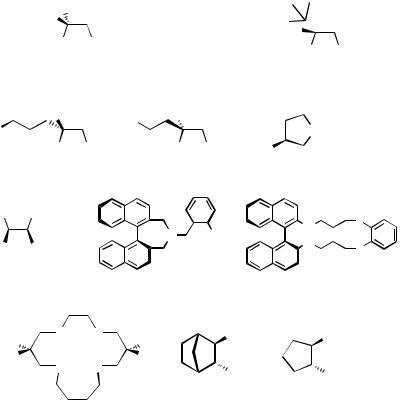
794 |
III Pd-CATALYZED CROSS-COUPLING |
H
R
Me2N PPh2
R = Me: (S)-alaphos (10a): 38% ee (S) [14],[15]
R = PhCH2: (S)-phephos (10b): 71% ee (S) [14],[15] R = i-Pr: (S)-valphos (10c): 81% ee (S) [14],[15]
H 
Me2N PPh2
(R)-t-leuphos (10d):
83% ee (R)[14],[15]
|
H |
|
|
SMe |
|
H |
|
|
|
|
|
|
|
|
|
|
|
||
MeS |
|
|
|
|
|
|
|
|
|
|
|
|
|
N |
|
R |
|
|
|
Me2N |
PPh2 |
|
|
Me2N |
PPh2 |
Ph2P |
|
|
|
|
|
||||||||
|
|
|
|
|
|||||||||||||||
|
|
|
|
|
|
|
|
|
|
||||||||||
(R )-12a: 88% ee (R) [17] |
(S)-12b: 65% ee (S)[18] |
(S)-13 |
|
|
|||||||||||||||
|
|
|
|
|
|
|
|
|
|
(R = CH2Ph): 89% ee (R)[19],[20] |
|||||||||
Ph |
Ph |
|
|
|
|
|
|
|
|
|
|
|
|
Me |
Ph |
||||
|
|
|
|
|
|
|
|
|
|
|
|
|
|
||||||
|
|
|
|
|
|
|
|
|
|
|
|
|
|
|
|
||||
|
|
|
|
|
|
N |
|
PPh2 |
|
|
|
N |
P |
||||||
|
|
|
|
|
|
|
|
|
|
|
|
||||||||
Me2N |
PPh2 |
|
|
|
|
|
|
|
|
N |
P |
||||||||
|
|
|
|
|
|
|
|
|
|
|
|
|
|
|
|
||||
|
|
|
|
|
|
|
|
|
|
|
|
|
|
|
|
|
|
||
|
|
|
|
|
|
|
|
|
|
|
|
|
|
Me |
Ph |
||||
|
|
|
|
|
|
|
|
|
|
|
|
|
|
|
|
|
|
||
(1R,2S)-14: |
|
|
(S)-15: 46% ee (R)[22],[23] |
|
|
(S)-16: 16% ee (R)[24] |
|||||||||||||
66% ee[21] |
65% ee (Pd)[21] |
|
|
|
|
|
|
|
|
|
|
|
|
|
|
|
|
||
H |
S |
S |
|
NMe2 |
|
|
|
PPh2 |
|
|
|
PPh2 |
|
|
|||||
|
|
|
|
|
|
|
|
|
|
|
|
|
|
|
|
|
|||
Me2N |
S |
S |
|
H |
|
|
|
PPh2 |
|
|
|
PPh2 |
|
|
|||||
|
|
|
|
|
|
|
|
||||||||||||
|
|
|
|
|
|
|
|
|
|
|
|
||||||||
|
|
|
|
|
|
|
|
|
|
|
|
|
|
|
|||||
|
|
|
|
|
|
(R,R)-norphos (18): |
19: 47% ee (S)[12],[28] |
||||||||||||
17: 46% ee (R)[25],[26] |
|
67% ee (S)[27] |
|
|
|
|
|
|
|
|
|
||||||||
Scheme 3 (Continued )
It was found that the ferrocenylphosphines containing a (dialkylamino)alkyl group on the side chain are effective for the cross-coupling of 1 catalyzed by nickel complexes. Ferrocenylmonophosphine, (S)-(R)-PPFA (5), and -bisphosphine, (S)-(R)-BPPFA (6), gave the coupling product 3 with 68% ee and 65% ee, respectively. The presence of the (dialkylamino)alkyl side chain is of primary importance for the high selectivity and the enantioselectivity is strongly affected by the structure of the dialkylamino group. The ferrocene planar chirality in 5 plays an important role in the enantiocontrol rather than the carbon central chirality on the ferrocene side chain, which is shown by comparison of the enantioselectivity with that observed with its diastereoisomer (R)-(R)-PPFA (6) or 7 that lacks the central chirality. A palladium catalyst coordinated with (S)-(R)-PPFA (5) ligand has been shown to have essentially the same enantioselectivity as the corresponding nickel catalyst.[9] The amino group is proposed to coordinate with the magnesium atom in the Grignard reagent at the transmetallation step in the catalytic cycle, where the coordination occurs selectively with one of the enantiomers of the racemic Grignard reagent to bring about high selectivity, although the coordination has not been supported by NMR studies of a palladium complex.[11] The influence of the extent of conversion on enantioselectivity
has |
been |
studied in the reaction of the Grignard reagent 1 with 2 |
catalyzed |
by |
the |
nickel |
complex of (S)-(R)-BPPFA (8).[12] A ferrocenylphosphine |
9, which |
is |
III.2.16 Pd-CATALYZED ASYMMETRIC CROSS-COUPLING |
795 |
analogous to PPFA but has a tetrahydroindenyl moiety, was more enantioselective than PPFA (5) for Pd-catalyzed asymmetric cross-coupling of 1 with 2 to give (R)-3 of 79% ee.[13]
Based on the high efficiency of the (dialkylamino)alkyl side chain on the ferrocenylphosphines, a series of -(dialkylamino)alkylphosphines 10 was prepared and used for Ni-catalyzed cross-coupling. Those substituted with a sterically bulky alkyl group at the chiral carbon center are more effective than the ferrocenylphosphine ligands. Valphos (10c) and t-leuphos (10d), which were prepared starting with valine and tert- leucine, respectively, gave the product 3 with over 81% ee.[14],[15] Use of polymersupported -(dialkylamino)alkylphosphine ligand 11, which is analogous to valphos (10c), gave 3-phenyl-1-butene (6) in somewhat lower enantiomeric purity.[16] A comparable enantioselectivity was observed with the -(dialkylamino)alkylphosphines 12 containing a sulfide group on the alkyl chain.[17],[18] The sulfur-bearing alkyl group is more effective than the simple alkyl side chain, the highest (88% ee) being obtained with 12a, which is derived from homomethionine. Several 3-diphenylphosphinopyrroli- dine-type ligands were prepared and used for the Ni-catalyzed Grignard cross-coupling of 1-phenylethylmagnesium chloride (1).[19],[20] The N-benzyl derivative 13 is most effective giving (R)-3 of 89% ee in the reaction with vinyl chloride. An asymmetric amplification was observed to some extent in the asymmetric cross-coupling with ligands 13. The enantioselectivities of palladium and nickel catalysts were shown to be the same (65 – 66% ee) in the reaction with the new chiral ( -aminoalkyl)phosphine ligand (1R,2S)-14, which was derived from erythro-2-amino-1,2-diphenylethanol.[21] Other (aminoalkyl)phosphines, based on the axially chiral 1,1 -binaphthyl skeleton, 15[22],[23] and 16,[24] have also been used for this Ni-catalyzed Grignard cross-coupling. Several chiral macrocyclic sulfides have been prepared and examined as chiral ligands for the Ni-catalyzed coupling reaction, although the enantioselectivity was not so high (46% ee with the tetrasulfide ligand 17).[25],[26] Nickel catalyst complexed with unfunctionalized chelating bisphosphine ligands, (R, R)-norphos (18)[27] and 19[12],[28], induced a high selectivity. Some other chiral ligands have also been used for the Ni-catalyzed reaction, but the enantioselectivities observed are generally low.[29]–[33]
In the reaction of 1-phenylethylmagnesium chloride (1) with (E )- -bromostyrene (20) forming (E )-1,3-diphenyl-1-butene (21) (Scheme 4), a palladium catalyst coordinated with PPFA (5) exhibited higher enantioselectivity (73% ee) than a nickel catalyst of the identical chiral ligand (52% ee).[9],[11] Palladium complexes of dimenthylphosphine 22,[34] 1-phenylethylamine derivative 23,[35] and norbornane derivative 24[36] have also been examined, though the enantioselectivity was not always high. Phosphinoferrocenyloxazoline (S)-(S)-25 was a more stereoselective ligand than its diastereomeric isomer for the Pd-catalyzed reaction of 1-phenylethylmagnesium chloride (1) with (E)-20 to give (E)-21 of 45% ee.[37] High enantioselectivity (94% ee) was reported by use of a nickel catalyst coordinated with ( -aminoalkyl)phosphine ligand (1R,2S)-14.[21] This is the highest selectivity for the cross-coupling of 1 with (E)-20 in the presence of nickel or palladium catalyst. Nickel complexes coordinated with phosphinophenyloxazolines (S)-26 were studied with regard to its structure and their use for asymmetric cross-coupling with (Z )- -bromostyrene ((Z )-21).[38] Interestingly, the enantioselectivity in the reaction of (E)-21 in the presence of (S )-26a was much lower (8% ee) than that (45% ee) of (Z )-21. Reverse of the enantioselection was observed with ligand 26b, which contains a hydroxymethyl group in place of isobutyl.
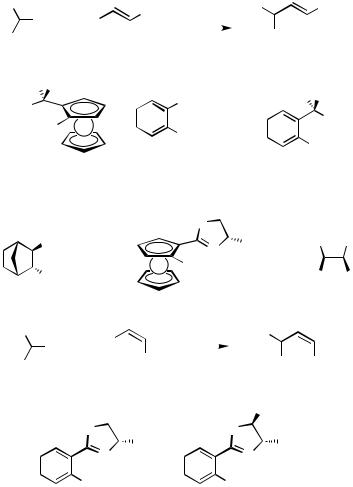
796 |
III Pd-CATALYZED CROSS-COUPLING |
|
|
|
|
||||||||||
|
Me |
|
|
|
Ph |
|
|
M/L* |
|
Me |
* |
Ph |
|
||
|
MgCl + |
Br |
|
|
|
|
|
|
|
||||||
|
|
|
|
|
|
|
|
|
|||||||
|
Ph |
|
|
|
|
|
|
Et2O |
|
Ph |
|
||||
|
1 |
|
|
|
(E)-20 |
|
M = Pd, Ni |
|
(E)-21 |
|
|||||
|
|
|
|
|
|
|
|
|
|
|
|
||||
|
H Me |
|
|
|
|
|
|
|
|
|
|
|
Me H |
|
|
|
Me2N |
|
|
|
|
|
PMen2 |
|
|
|
|||||
|
|
|
|
|
|
|
|
|
|
||||||
|
Fe |
|
|
|
|
|
|
|
|
|
|
NMe2 |
|||
|
|
|
|
|
|
|
|
|
|
|
|||||
|
Ph2P |
|
|
|
|
NMe2 |
|
|
|||||||
|
|
|
|
|
|
|
PPh2 |
|
|||||||
|
|
|
|
|
|
|
|
|
|
|
|||||
|
|
|
|
|
|
|
|
|
|
|
|
|
|
|
|
|
(S)-(R)-PPFA (5): |
22: 11% ee (R) (Pd)[34] |
23: 40% ee (R) (Pd)[35] |
||||||||||||
|
52% ee (R) (Ni)[9] |
|
|
|
|
|
|
|
|
|
|
|
|||
|
73% ee (Pd)[11] |
|
|
|
|
|
|
|
|
|
|
|
|
||
|
|
|
|
|
|
|
|
|
O |
|
|
|
|
||
|
OPPh2 |
|
|
|
|
|
|
N |
Pr-i |
|
Ph |
Ph |
|||
|
|
|
|
|
|
|
|
|
|
|
|
|
|||
|
N(Me)PPh2 |
|
|
Fe |
|
PPh2 |
|
|
Me2N |
PPh2 |
|||||
|
|
|
|
|
|
|
|
|
|
|
|||||
|
24: 13% ee (S) (Pd)[36] |
(S)-(S)-25: 45% ee (S) (Pd)[37] |
|
(1R,2S)-14: 94% ee (Ni)[21] |
|||||||||||
|
Me |
|
Br |
|
|
M/L* |
|
Me |
|
* |
|
||||
|
|
MgCl |
+ |
|
|
|
|
||||||||
|
|
|
|
Ph |
|
|
Et2O |
|
|
Ph Ph |
|
||||
|
Ph |
|
|
|
|
|
|
|
|
||||||
|
|
|
|
|
|
|
|
|
|
|
|
||||
|
1 |
|
|
(Z)-20 |
M = Pd, Ni |
|
|
(Z)-21 |
|
||||||
|
|
|
|
|
|
|
|
|
|
|
|||||
|
|
|
|
|
|
|
|
|
|
|
|
Ph |
|
|
|
|
|
|
O |
|
Bu-i |
|
|
|
|
O |
|
|
CH2OH |
|
|
|
|
|
|
|
|
|
|
|
|
|
|
|
|||
|
|
|
|
N |
|
|
|
|
|
N |
|
|
|
||
|
|
|
|
|
|
|
|
|
|
|
|
||||
|
|
|
PPh2 |
|
|
|
|
|
|
PPh2 |
|
|
|
||
|
|
|
|
|
|
|
|
|
|
|
|
||||
|
|
(S)-26a: 45% ee (S)[38] |
|
|
(S,S)-26b: 41% ee (R)[38] |
|
|||||||||
Scheme 4
For Ni-catalyzed asymmetric cross-coupling of 1-aryl-substituted ethyl Grignard reagents 27 with vinyl bromide (2), the chiral ferrocenylphosphine (S)-(R)-PPFA (5) and-(dialkylamino)alkylphosphines 10 are used (Scheme 5). The enantioselectivity is as high as that for the reaction of the 1-phenylethyl Grignard reagent (1). The coupling product (R)-28a was converted by a sequence of reactions into -curcumene (29) of 66% ee.[39] Oxidation of the coupling product 28b gave optically active 2-(4-isobutylphenyl)propionic acid (ibuprofen) (30, 80% ee), which is an anti-inflammatory agent.[15]
Asymmetric cross-coupling of secondary alkyl Grignard reagents that do not contain an aryl group such as phenyl on the chiral carbon center has not been so successful in terms of enantioselectivity as that of the 1-arylethyl Grignard reagent. The reaction of the 2-butyl Grignard reagents 31 with phenyl halides 32 was studied with nickel catalysts complexed with chiral homologues of 1,2-bis(diphenylphosphino)ethane (Scheme 6).[27],[40],[41] Palladium catalysts have not been used for this type of Grignard
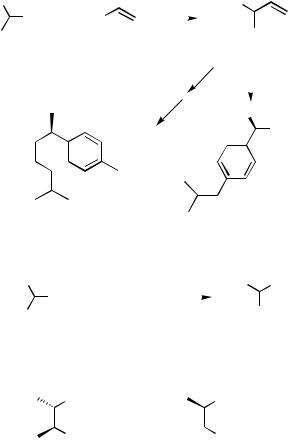
|
III.2.16 |
Pd-CATALYZED ASYMMETRIC CROSS-COUPLING 797 |
|||||||||||
Me |
|
|
|
|
|
Ni/L* |
Me |
* |
|||||
MgCl + |
Br |
|
|
|
|
|
|
|
|
|
|
||
|
|
|
|
Et2O |
|
Ar |
|||||||
Ar |
|
|
|
|
|
|
|||||||
|
|
|
|
|
|
|
|
||||||
27a: Ar = 4-MeC6H4 |
|
2 |
|
|
|
|
|
28a,b |
|||||
27b: Ar = 4-i-BuC6H4 |
|
|
|
|
|
|
|
|
Me |
|
|||
|
|
|
|
|
|
|
|
|
|||||
|
|
|
|
|
|
|
|
|
|
|
|
||
|
|
|
|
|
|
|
|
|
|
|
|
||
|
|
|
|
|
|
|
|
|
|
|
|
|
COOH |
|
|
|
29: 66% ee |
|
|
|
30: 80% ee |
||||||
|
|
|
|
|
|
||||||||
|
|
|
|
|
|
||||||||
|
|
|
|
|
|
||||||||
|
|
|
|
|
|
||||||||
|
|
|
|
|
|
||||||||
L* = (S)-(R)-PPFA (5) |
|
|
|
|
L* = (S)-valphos (10c) |
||||||||
|
|
|
|
|
Scheme 5 |
|
|
|
|
||||
Me |
+ |
X′ |
|
|
|
Ni/L* |
|
Me |
* Ph |
||||
|
MgX |
|
Ph |
|
|
|
|
Et |
|||||
|
|
|
|
|
|
||||||||
Et |
|
|
|
|
|
|
|
|
|
|
|||
31 |
|
|
|
32 |
|
|
|
|
|
|
|
33 |
|
X, X′ = Cl, Br, I |
|
|
|
|
|
|
|
|
|||||
|
PPh2 |
|
|
|
|
|
|
PPh2 |
|
||||
|
PPh2 |
|
|
|
|
|
|
PPh2 |
|
||||
(S,S)-chiraphos (34) (R)-prophos (35)
Scheme 6
reagents. The highest enantiomeric purity (55% ee) of the product, 2-phenylbutane (33), was obtained in the reaction of 31 (X Br) with 32 (X Br) in the presence of a nickel complex coordinated with 1,2-bis(diphenylphosphino)cyclopentane (19). Use of (S,S)- chiraphos (34) as a chiral ligand produced (S)-33 of 43% ee. Detailed studies on the reaction of 31 (X Cl, Br, I) with 32 (X Cl, Br, I) in the presence of nickel/(R)- prophos (35) catalyst revealed that the absolute configuration of the coupling product as well as the enantioselectivity is dependent on the halogen atoms in both the Grignard reagent and phenyl halides.
Use of 1-phenylethylzinc reagents in place of the corresponding Grignard reagents sometimes increases the stereoselectivity (Scheme 7). The reaction of zinc reagents is usually more efficiently catalyzed by palladium complexes than nickel complexes. The reaction of zinc reagents 36 prepared from 1 with a zinc halide in THF in the presence of a palladium catalyst coordinated with a chiral ferrocenylphosphine [(R)-(S)-PPFA (5)] proceeded with 85 – 86% enantioselectivity.[42] The selectivity is higher than that observed for the reaction with 1-phenylethyl Grignard reagent (see also Scheme 3). The highest
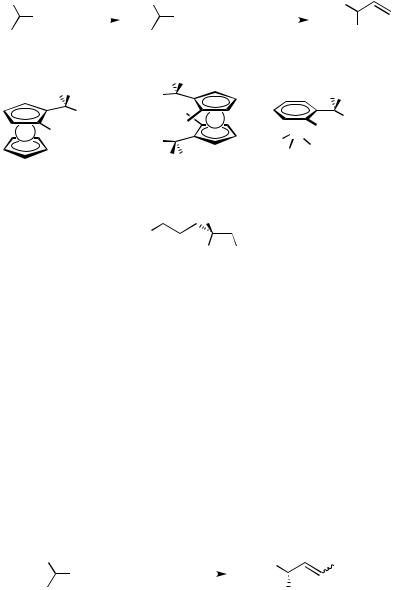
798 III Pd-CATALYZED CROSS-COUPLING |
|
|
|
|
|
|
|
|
||
Me |
Me |
|
|
CH2 =CHBr (2) |
|
Me |
* |
|||
MgCl |
ZnX2 |
ZnX |
|
|
|
|||||
Ph |
Ph |
|
|
Pd/L* (catalyst) |
|
Ph |
||||
1 |
|
36 |
|
|
THF |
|
|
|
|
3 |
H Me |
H Me |
|
|
|
|
|
|
|
|
|
Me2N |
|
|
|
|
|
|
H Me |
|||
|
|
|
|
|
|
|
|
|||
|
NMe |
Ph2P |
|
|
|
|
|
|
|
|
|
|
|
|
|
|
|
|
|||
2 |
Ph2P |
Fe |
|
|
|
|
|
NMe2 |
||
|
|
|
|
|
|
PPh2 |
||||
Fe PPh2 |
|
|
|
Cr |
|
|||||
Me2N |
|
|
OC |
CO |
|
|||||
|
|
|
|
|
|
|
|
|||
|
|
H Me |
|
|
OC |
|
|
|||
|
|
|
|
|
|
|
|
|
|
|
(R)-(S)-PPFA (5): |
37: 93% ee (R)[43] |
38: 61% ee (S)[45] |
||||||||
85 –86% ee (S)[42] |
|
|
|
|
|
|
|
|
|
|
|
|
|
H |
|
|
|
|
|
|
|
|
|
MeS |
|
|
|
|
|
|
|
|
|
|
Me2N |
PPh2 |
|
|
|
|
|
||
|
|
(R)-12a: 70% ee (R) [Ni][46],[47] |
|
|
|
|
|
|||
|
|
Scheme 7 |
|
|
|
|
|
|
||
enantioselectivity in the formation of (R)-3, 93% ee, was obtained with the C2-symmetric ferrocenylphosphine ligand 37 containing two phosphorus atoms and two aminoalkyl side chains on the ferrocene skeleton.[43],[44] An aminoalkylphosphine 38 ligand, which is analogous to PPFA (5) but having the ( 6-benzene)chromium structure in place of ferrocene, showed a slightly lower selectivity (61% ee) in the reaction of 1-phenylethylzinc reagent.[45] Nickel catalysts of aminoalkylphosphines 12 have been used for asymmetric cross-coupling of the zinc reagent 36,[46],[47] which gave (R)-3 of 70% ee.
In the asymmetric cross-coupling of the zinc reagent 36 catalyzed by Pd/(S)-(R)-PPFA (5), (E)- -bromostyrene (20)[42] and (E )- and (Z )-1-bromo-2-(phenylthio)ethenes (39) have also been used. Enantiomerically enriched alkenyl sulfides 40 could undergo the second cross-coupling, the sulfide being replaced by the Grignard reagent in the presence of a nickel catalyst (Scheme 8).[48]
Me |
|
PhSCH=CHBr (39) |
Me |
SPh |
|
ZnX |
|||
|
|
|
|
|
Ph |
Pd/(S)-(R)-PPFA (5) |
|
Ph |
|
|
|
|||
|
|
|
||
|
36 |
|
(E)-40: 30% ee (R) |
|
|
|
|
(Z)-40: 55% ee (R) |
|
Scheme 8
As a coupling partner of 1-phenylethyl Grignard reagent 1, allyl phenyl ether gave (R)-4-phenyl-1-butene of 58% ee in the reaction catalyzed by NiCl2[(S,S)-chiraphos (34)].[49] Pd-catalyzed asymmetric cross-coupling was successfully applied to the synthesis of optically active allylsilanes (Scheme 9).[50],[51] The reactions of -(trimethylsilyl)ben- zylmagnesium bromide (41) with vinyl bromide (2), (E)-bromopropene ((E)-42), and
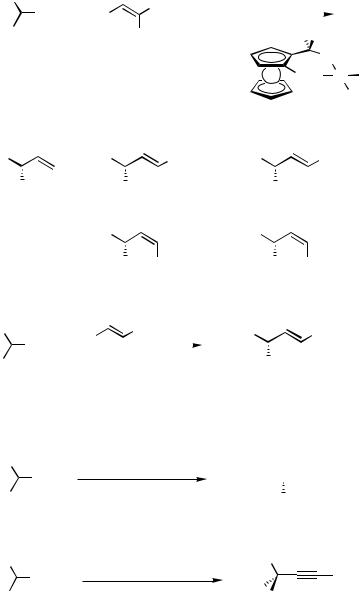
|
III.2.16 |
Pd-CATALYZED ASYMMETRIC CROSS-COUPLING 799 |
||||
Me3Si |
|
R1 |
PdCl2[(R)-(S)-PPFA (5)] |
|||
|
(0.5 mol %) |
|
|
|||
MgBr |
+ Br |
|
|
|||
|
|
|
|
|
||
Ph |
|
R2 |
|
H Me |
||
41 |
2: R1 = R2 = H |
|
NMe2 |
|||
|
(E)-42: R1 = Me, R2 = H |
Fe |
PPh2 Pd Cl |
|||
|
(Z)-42: R1 = H, R2 = Me |
|||||
|
|
|
Cl |
|||
|
(E)-20: R1 = Ph, R2 = H |
|
|
|||
|
(Z)-20: R1 = H, R2 = Ph |
PdCl2[(R)-(S)-PPFA (5)] |
||||
Me3Si |
Me3Si |
Me |
Me3Si |
Ph |
||
Ph |
|
Ph |
Ph |
|
|
|
43a: 95% ee (R) |
(E)-43b: 85% ee (R) |
(E)-43c: 95% ee (R) |
||||
|
Me3Si |
|
|
Me3Si |
|
|
|
|
Ph Me |
Ph |
Me |
||
|
(Z )-43b: 24% ee (R) |
(Z)-43c: 13% ee (R) |
||||
R3Si
MgCl
Me
44a− c
PhMe2Si
MgCl
Me
44b
Me3Si
MgBr
Ph
41
Br |
Ph (E)-20 |
R3Si |
Ph |
PdCl2[(R)-(S)-PPFA (5)] |
|
Me |
|
|
(0.5 mol %) |
|
|
45a: R3Si = Me3Si, 68% ee (S) 45b: R3Si = PhMe2Si, 68% ee (S) 45c: R3Si = Et3Si, 93% ee (S)
Br

 (E)-46
(E)-46
PdCl2[(R)-(S)-PPFA (5)]
(0.5 mol %)
Br  Ph
Ph
PdCl2[(R)-(S)-PPFA (5)]
(0.5 mol %)
Scheme 9
PhMe2Si


Me
47: 45% ee (S)
Me3Si
Ph
Ph
H
(S)-48: 18% ee
(E)-bromostyrene ((E)-20) in the presence of 0.5 mol % of a palladium complex coordinated with chiral ferrocenylphosphine, (R)-(S)-PPFA (5), gave the corresponding (R)-allylsilanes (43) with 95%, 85%, and 95% ee, respectively, which were substituted with phenyl group at the chiral carbon center bonded to the silicon atom. These allylsilanes were used for the SE reactions forming optically active homoallyl alcohols and -allylpalladium complexes.

800 |
III Pd-CATALYZED CROSS-COUPLING |
A lower stereoselectivity was observed with the (Z)-alkenyl bromides (Z)-42 and (Z)-20. The palladium/PPFA catalyst was also effective for the reaction of 1-(trialkylsilyl)ethylmagne- sium chlorides 44 with (E)-bromostyrene ((E)-20). The enantioselectivity was dependent on the trialkylsilyl group, triethylsilyl being the best to produce (S)-1-phenyl-3-silyl-1-butene (45c) of 93% ee. The dienylsilane (S)-47, which is 45% enantiomerically pure, was also prepared by asymmetric cross-coupling with the dienyl bromide (E)-46. Pd-catalyzed asymmetric cross-coupling of -(trimethylsilyl)benzylmagnesium bromide (41) was also applied for the synthesis of the optically active propargylsilane 48 (18% ee) by using 1-bromo-2-pheny- lacetylene as a coupling partner.[52]
C. ENANTIOPOSITION-SELECTIVE ASYMMETRIC CROSS-COUPLING
Pd-catalyzed asymmetric cross-coupling has been applied to asymmetric synthesis of planar chiral tricarbonyl( 6-o-dichlorobenzene)chromium complexes and axially chiral biaryl molecules by an enantioposition-selective reaction.
Planar chiral tricarbonyl( 6-arene)chromium complexes were prepared by catalytic asymmetric cross-coupling of tricarbonyl( 6-o-dichlorobenzene)chromium (49) with alkenylor arylmetal reagents (Scheme 10).[53],[54] In the presence of 10 mol % of a palladium catalyst generated from [PdCl( 3-C3H5)]2 and ferrocenylmonophosphine (S)-(R)-PPFA (5), an enantioposition-selective substitution of one of the chloride atoms takes place to give the planar chiral monosubstitution products 50 together with a minor amount of the disubstitution products 51, which are achiral. The highest enantiomeric excess of the monosubstitution product is 69% ee, which was reported for the phenylation of 49 with phenylboronic acid to afford (1S,2R)-50a. Alkenylation with ethenylboronic acid or propen-2-ylboronic acid also proceeded enantioselectively to give the corresponding monoalkenylation product 50b (38% ee) or 50c (44% ee). Interestingly, use of ethenyltributyltin as the vinylation reagent in place of ethenylboronic acid resulted in the formation of the racemic product 50b while use of ethenylzinc chloride gave 50b of 42% ee.
|
|
Cl |
Ρ −Μ |
|
|
|
Cl |
+ |
|
|
R |
|
|
|
|
|
|
||||||
|
|
Cl |
|
|
R |
|
|
R |
|||
|
|
|
|
|
|
||||||
Cr |
Pd/(S)-(R)-PPFA (5) |
Cr |
|
Cr |
|||||||
|
|
|
|
||||||||
OC |
CO |
OC |
CO |
|
OC |
CO |
|||||
|
|
|
|||||||||
OC |
|
|
OC |
|
OC |
||||||
|
|
|
|
|
|
||||||
49 −M = −B(OH)2,−ZnCl, −SnBu3 |
(1S,2R)-50a−c |
|
51 |
|
|||||||
a: R = Ph
b: R = CH=CH2
c: R = CMe=CH2
Scheme 10
Enantioposition-selective asymmetric cross-coupling has also been successfully applied to the synthesis of axially chiral biaryl molecules (Scheme 11).[55],[56] Reaction of the achiral ditriflate 52 with 2 equiv of phenylmagnesium bromide in the presence of lithium bromide and 5 mol % of PdCl2[(S)-phephos (10b)] at 30 °C for 48 h gave an 87% yield of the monophenylation product (S)-53, which is 93% ee, and a 13% yield of diphenylation product 54. The enantiomeric purity of the monophenylation product
